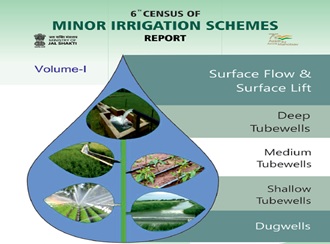08 December, 2025
Minor Irrigation Census (MIC) 2023
Sun 03 Sep, 2023
- Recently, the sixth census report on minor irrigation schemes was released by the Department of Water Resources, River Development and Ganga Rejuvenation, Ministry of Jal Shakti.
- MIC finds that electricity is the dominant source (3/4th) of power to extract water, over diesel, windmills, and solar pumps.
- The MIC is a compendium of borewells, tubewells, and other privately owned irrigation sources by farmers.
The use of electricity:
- While it showed a quantum jump from powering only 56% of sources in 2011 to 70% in 2017, the latest report shows electricity as powering 76% of sources - a slower growth rate.
- This electrification of groundwater withdrawal corresponds to a rise in the use of tube wells and borewells that are capable of extracting water at greater depths.
Minor Irrigation Census
- The First Census of Minor Irrigation schemes was conducted with reference year 1986-87 and five censuses have been done since 1986,87, 1993-94, 2000-01, 2006-07 and 2013-14.
- Sixth Minor Irrigation Census with reference year 2017-18 has been completed in 32 States/UTs (except New Delhi, Daman & Diu, Dadra & Nagar Haveli and Lakshadweep).
Sixth Census Report on Schemes for Irrigation (MI):
- According to this report, there are 23.14 million minor irrigation (MI) schemes in the country, of which 21.93 million (94.8%) are groundwater (GW) and 1.21 million (5.2%) are surface water (SW) schemes.
- During the 6th Minor Irrigation Census, an increase of about 1.42 million minor irrigation schemes has been registered as compared to the 5th Census.
- At the national level, both GW and SW schemes have increased by 6.9% and 1.2%, respectively.
- Out of all MI schemes, 97.0% are ‘in use’, 2.1% are ‘temporarily not in use’ whereas 0.9% are ‘permanently not in use’.
Ownership:
- 96.6% of minor irrigation schemes are privately owned.
- The share of private entities in the ownership of groundwater schemes is 98.3%.
- The share in surface water schemes is 64.2%.
- Of all individually owned plans, 18.1% are owned by women.
- For the first time, data was collected on the gender of the participants of the Minor Irrigation (MI) scheme.
- About 60.2% of the schemes have a single source of finance while 39.8% of the schemes have more than one source of finance.
- 79.5% of the schemes are being financed from individual farmer's own savings.
Significance:
- This report will be useful for planners, policy makers, researcher scholars, agricultural and ground water scientists, administrators & all concerned with development of irrigation and agricultural economy of the country.
Exam oriented Static facts
- States with highest number of micro irrigation schemes in the country: Uttar Pradesh, (17.2%), Maharashtra (15.4%), Madhya Pradesh, (9.9%), Tamil Nadu (9.1%).
- Maharashtra is the leading State in dug-wells, surface flow and surface lift schemes.
- Uttar Pradesh, Karnataka and Punjab are the leading States in shallow tube-wells, medium tube-wells and deep tube-wells, respectively.
- In SW schemes, Maharashtra, Karnataka, Telangana, Odisha and Jharkhand have the highest share.
- Initiatives taken by the government related to irrigation:
- Pradhan Mantri Krishi Sinchai Yojana (PMKSY): Launch Year: 2015
- Per Drop More Crop Launch Year: 2015-16


















